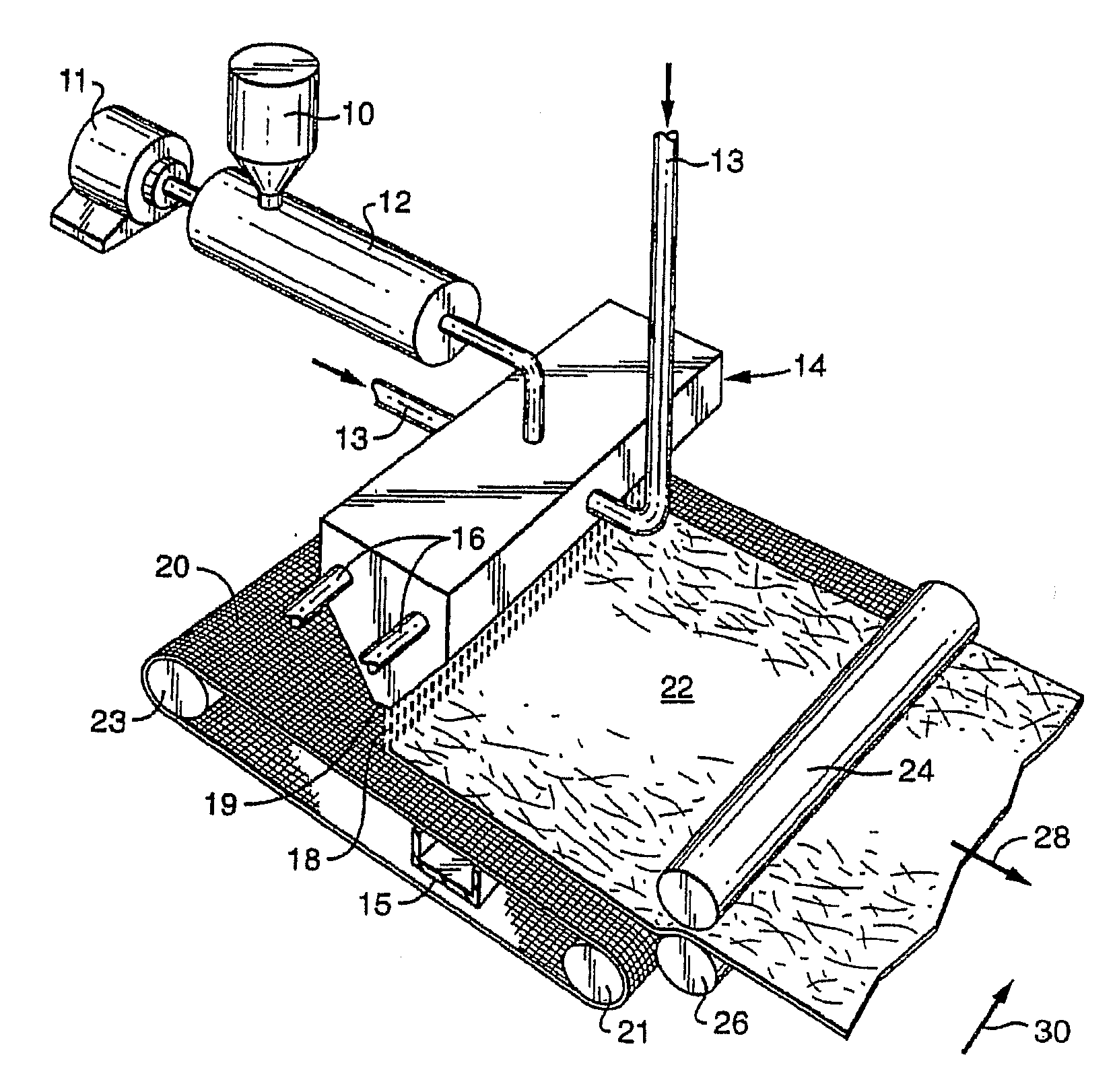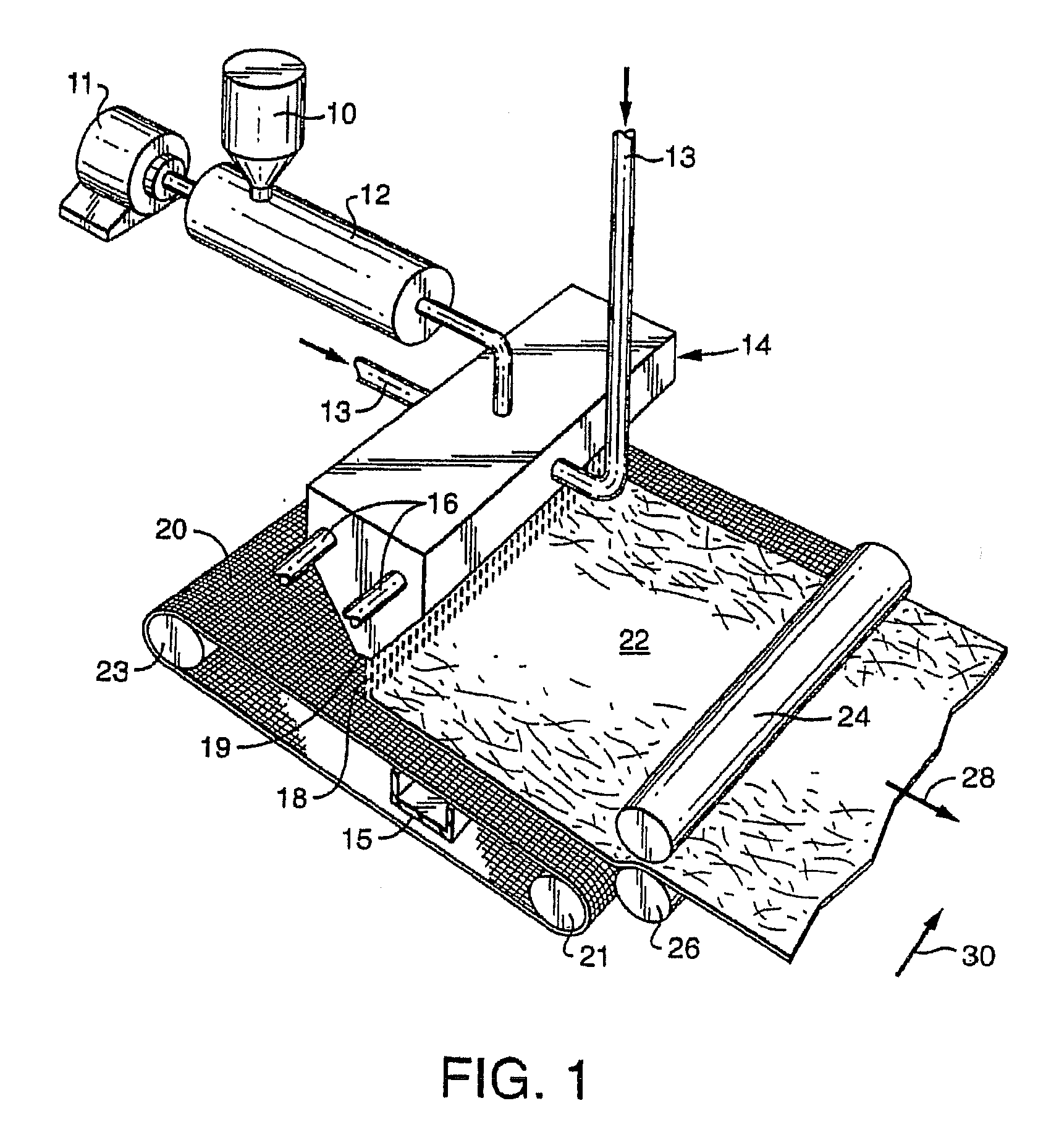Biodegradable polylactic acid for use in nonwoven webs
a technology of biodegradable polylactic acid and nonwoven webs, which is applied in the field of ##biodegradable nonwoven webs, can solve the problems that conventional polylactic acid is not typically suitable for meltblowing processes
- Summary
- Abstract
- Description
- Claims
- Application Information
AI Technical Summary
Problems solved by technology
Method used
Image
Examples
example 1
[0087]A polylactic acid resin was initially obtained from Biomer, Inc. under the designation BIOMER™ L-9000. A co-rotating, twin-screw extruder was employed (ZSK-30, diameter) that was manufactured by Werner and Pfleiderer Corporation of Ramsey, N.J. The screw length was 1328 millimeters. The extruder had 14 barrels, numbered consecutively 1-14 from the feed hopper to the die. The first barrel (#1) received the BIOMER™ L-9000 resin via a volumetric feeder at a throughput of 40 pounds per hour. The fifth barrel (#5) received varying percentages of a reactant solution via a pressurized injector connected with an Eldex pump. The reactant solution contained 1,4-butanediol (87.5 wt. %), ethanol (6.25 wt. %), and titanium propoxide (6.25 wt. %). The screw speed was 150 revolutions per minute (“rpm”). The die used to extrude the resin had 4 die openings (6 millimeters in diameter) that were separated by 4 millimeters. Upon formation, the extruded resin was cooled on a fan-cooled conveyor b...
example 2
[0092]A modified resin of Example 1 (Sample 2) was used to form a meltblown web (“MB”). Meltblown spinning was conducted with a pilot line that included a Killion extruder (Verona, N.Y.); a 10-feet hose from Dekoron / Unitherm (Riviera Beach, Fla.); and a 14-inch meltblown die with an 11.5-inch spray and an orifice size of 0.015 inch. The modified resin was fed via gravity into the extruder and then transferred into the hose connected with the meltblown die. Table 4 shows the process conditions used during spinning.
TABLE 4Modified PLA L-9000 MB spinning conditionsExtruderScrewPrimary AirZone 1Zone 2Zone 3Zone 4SpeedTorquePressureHoseDieTemperaturePressure(F.)(F.)(F.)(F.)(rpm)(Amps)(Psi)(F.)(F.)(F.)(Psi)385375375375447237538040034
[0093]A sample of the modified polylactic acid web was also collected and analyzed with an electronic scanning microscope (“SEM”) at different magnitudes. A micrometer scale bar was imprinted on each photo to permit measurements and comparisons. FIGS. 3 and 4 ...
PUM
| Property | Measurement | Unit |
|---|---|---|
| temperature | aaaaa | aaaaa |
| polydispersity index | aaaaa | aaaaa |
| temperature | aaaaa | aaaaa |
Abstract
Description
Claims
Application Information
 Login to View More
Login to View More - R&D
- Intellectual Property
- Life Sciences
- Materials
- Tech Scout
- Unparalleled Data Quality
- Higher Quality Content
- 60% Fewer Hallucinations
Browse by: Latest US Patents, China's latest patents, Technical Efficacy Thesaurus, Application Domain, Technology Topic, Popular Technical Reports.
© 2025 PatSnap. All rights reserved.Legal|Privacy policy|Modern Slavery Act Transparency Statement|Sitemap|About US| Contact US: help@patsnap.com



